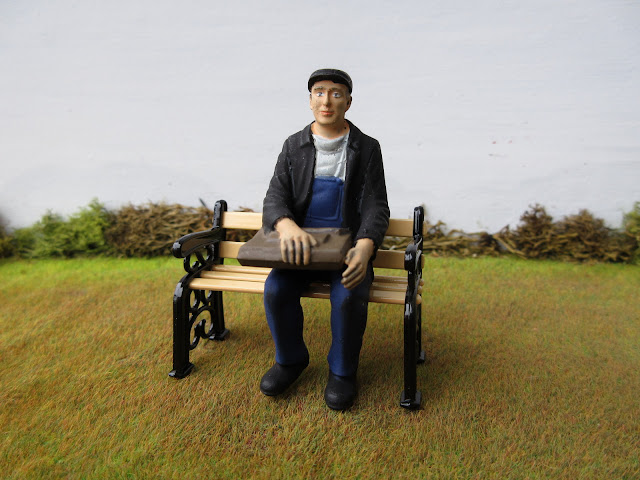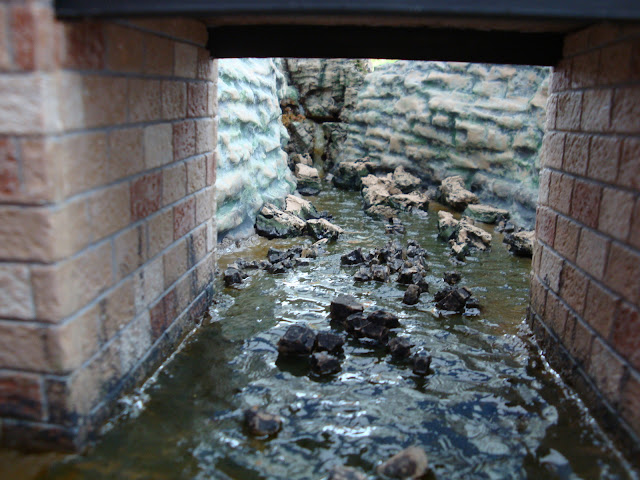Longstone
(21st layout)
An early photo of the village board.
Here is summary of the layout with some early photographs.
Legend
The fictitious layout "Longstone" depicts an 15" gauge estate railway 3.25 miles long. It runs from Longstone village southwards to Hobground sidings alongside the standard gauge York to Scarborough line near the village of Whisperdales, entirely within the estate owned by Lord Mitchell who took over ownership of the woollen mill at Spring Head. The line started as a horse tramway in the late 19th century for transporting supplies, coal and products to and from the mill and was gradually improved by it's previous owner for use as a railway.
From the Longstone Hall maintenance shed the line runs into the village station, at 1/4 of a mile there is a small halt at Spring Head (Mill), and, running over moorland at 1 1/2 miles (the steepest part of the line), the village of Dalebrook is reached where there is a passing loop and siding. Attaining a low lying valley at 2 1/4 miles High Bank Farm is reached where there is a farm siding, then proceeding along the lowest part of the line by the Whisper Beck and after another mile the end of the line is Hobground (for Whisperdales village).(Click on images to enlarge)
Loco No.1 "Proteus" in the rock cutting at Fox Gill.
The small railway has many sources of traffic: supplies, coal and raw wool to the mill, and woven products leaving the mill, mill workers transport, guests to Longstone for "Longstone Hall" and gardens, and also visitors and walkers for the moors area around Longstone.
"Proteus" again, seen leaving the mill sidings with a goods train.
It is about to go through the "hole in the sky" which leads to the village station.
On the back scenes we have used cut-up Yorkshire calendar pictures to give more depth to the scenes.
It is about to go through the "hole in the sky" which leads to the village station.
On the back scenes we have used cut-up Yorkshire calendar pictures to give more depth to the scenes.
The Layout
The layout shows three scenes, the village with station, Fox Gill and moorland area, and Spring Head Mill. It is viewed on three sides, with a fiddle yard and operating area on the fourth side.At present I have five Smallbrook Studio locomotives:
No. 1 "Proteus" - a Harlequin kit, and the loco that started it all.
No. 2 "Jiro" - a Columbine kit.
No. 3 "Triton" - a Pierrot kit.
No. 4 "Delta" - another Columbine kit.
No. 5 "Quinto" - a modified Katie kit.
The wagons are a mix of Sidelines (Black Dog Mining/Pepper7) and Smallbrook Studios kits.
Coaches are mainly scratch built, but include two Decauville open sided 4-wheeler's by Smallbrook Studio.
I hope to add a later post with details of the locomotives and stock.
This is the passenger shelter just after completion with loco No.4 "Delta" passing by on test.
The wooden fencing in the foreground is a Lemax product.
No.3 "Triton" in the mill yard with general supplies for the mill.
Baseboards are made of 6 mm and 9 mm ply wood. Two baseboards are 39" x 22" (1000 mm x 550 mm) and are supported by built in legs. They are the fiddle-yard and Fox Gill boards. The village and mill boards are suspended between them and are 43" x about 19" each (1090 mm x 490 mm), but the mill board is slightly wider to get the turnout to the mill fitted in.
Track on the scenic sections is Peco "0-16.5" Streamline, and in the fiddle yard is Peco "00" Setrack. The turnouts in the fiddle yard are controlled by Peco PL-11 Side Mounted point motors, and in the scenic sections we use Tortoise Slow Motion Machines.
The first scene constructed, at the village stores.
The street lamp is an altered Lemax product, and the post box is one of the "Miniature World" stone resin items.
A longer view of the village board while the station was under construction with "Triton" and empty wagons.
No.4 "Delta" shunting at the mill rail entrance.
"Proteus" is seen crossing the bridge at Fox Gill.
We later added some low trees, sheep and other animals to the scene.
"Proteus" again, with bogie coach arriving at the newly constructed station.
I wasn't happy with the back scene picture of Longstone Hall above the bridge, so later we changed it for another building.
"Triton" passing the end of the road in the village.
The chapel was an amalgamation of several Yorkshire chapel features from photographs.




















































